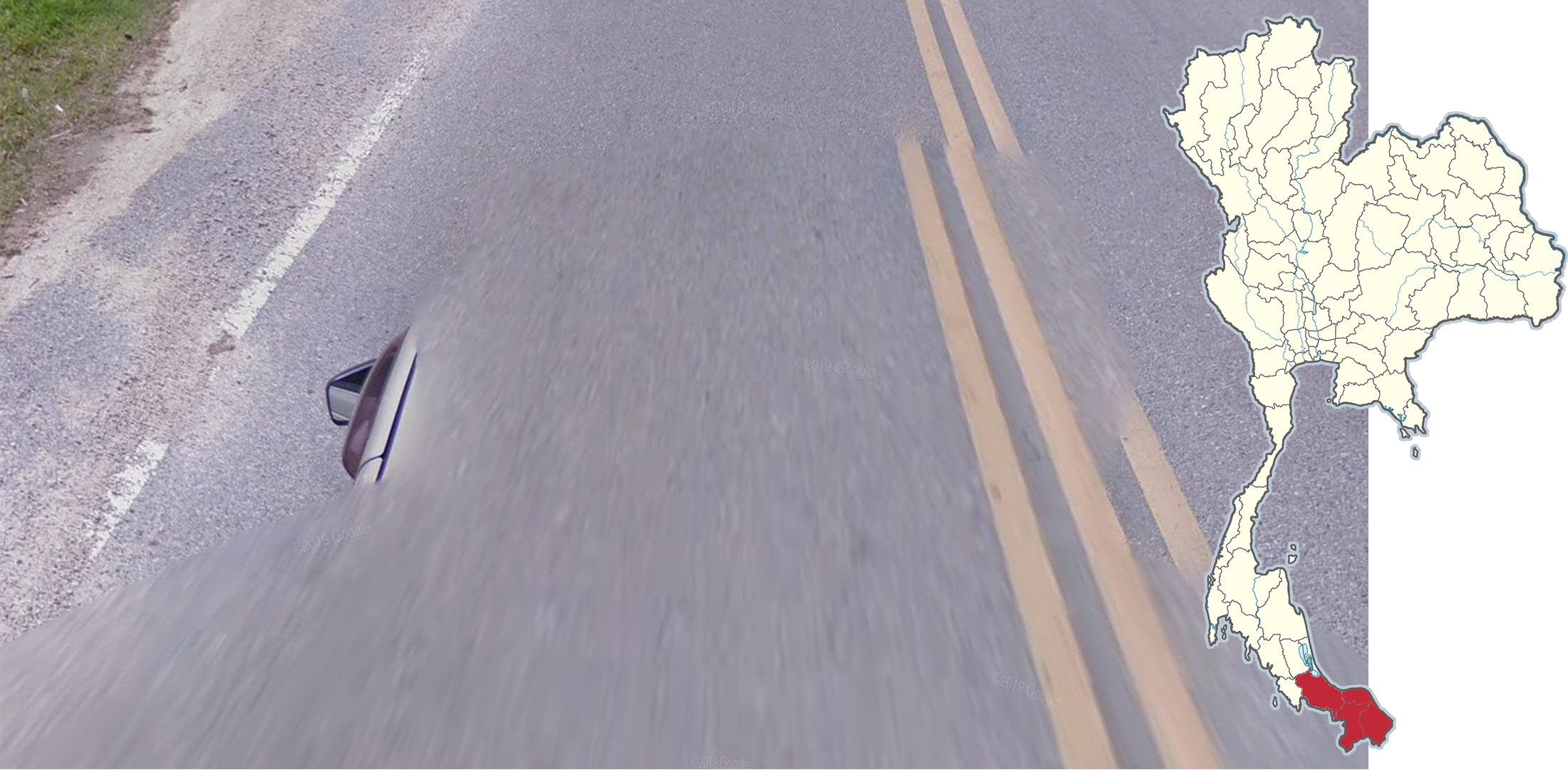
Thailand
Thai script is compact and in many fonts has tiny circles within most letters.
NOTE: The Cambodian (Khmer) script often has longer lines and more accents underneath the lettering, as opposed to the Thai script. The Lao script looks similar to the Thai script. Make sure to check the driving side before guessing.
Thailand has yellow middle lines. These middle lines are either solid or dashed lines.
NOTE: Malaysia only has white middle lines.
Directional signs on smaller roads are white, and are composed of two signs: one with an arrow at the bottom, and one with the information at the top. These can have place names. When they do not, you will see them as just the road number with a Garuda. Moreover, highway signs are green, and frequently feature the place names in Latin script below the Thai name.
These two road markers are generally found in Thailand. They will either have a white or a black Garuda on them.
NOTE: White Garudas are found on country roads and appear white on the map, while black ones are found on province roads and appear dark blue on the map.
On the map, national roads are white-and-black, while provincial roads are blue-and-yellow.
Thailand often has many flags lining the side of its streets. Aside from the national flag, you can often see royal flags, which are usually yellow.
Most Generation 3 coverage has no visible Street View car.
NOTE: Vientiane and some Generation 3 coverage in Cambodia will also not have a visible car. Bike trekkers and a white car with a brake light can rarely be found all throughout the country in Generation 3.
Thai landline phone numbers have 9 digits. The first digits of phone numbers are the area code. The Bangkok area code is 02, the other area codes have three digits. The area codes are grouped, so even just learning the first digit is useful.
NOTE: Mobile phone numbers start with 08 or 09 and have 10 digits. None of these numbers overlap with the area codes. Numbers starting with 06 are also not regional.
Waystones and road signs on provincial roads will often provide a two-letter abbreviation of the province in Thai script. They will not appear on waystones or road signs for national roads.
You can use this site to view and practice all province abbreviations.
These black boxes will often provide a three-letter abbreviation of the province. Two formats are used:
Starting with the abbreviation followed by 4 numbers
Starting with TCC-L2, or rarely TCC-L1, followed by the abbreviation
Shown in the picture is the abbreviation “NTB” for Nonthaburi. The abbreviations may vary slightly in each province depending on the format.
NOTE: Other boxes may feature different formats that correspond to the subdistrict of the province.
The majority of Muslims in Thailand live in the very south of the country. In these areas, you will often see Islamic religious attire, Jawi script, based on the Arabic script, on signs and mosques.
Cassava is a bush-like plant with digitate leaves. It can be found throughout most of Thailand, but is considerably more common in the central and northeastern plains.
Durian plantations are most common around Chanthaburi, but can be found around the peninsula and other areas. When they are young, they can be identified by their cone-shaped appearance. When fully grown, durian trees can be identified by their dark bark, branches that nearly reach the ground, and oblong leaves with pointed tips.
Tectona grandis, also known as teak, is most commonly found in high densities in the north. It can be recognized by its large leaves and yellow flowers.
NOTE: Teak trees are often used for decoration along highways.
Pine trees, specifically Pinus latteri, or Tenasserim pines, are more or less exclusive to the north and northwest of the country.
Codiaeum variegatum, also known as garden croton, is a decorative plant recognised by its yellow, orange and red leaves. It is most common around Ranong and other coastal provinces.
Regular poles with a Chilean style indent are found around Bangkok.
NOTE: Larger and thicker poles with indents are found on highways all throughout the country.
Bangkok uses pink and yellow on green taxis.
NOTE: Yellow on green taxis may rarely be seen elsewhere, but pink taxis are practically exclusive.
Rolling hills of corn or sugar cane fields can be found in the west of the Tak province. In this area, paved roads are often very brown.
Khao Sam Roi Yot National Park in western Prachuap Khiri Khan features large, distinct exposed rock mountain massifs. Notably, the mountains can be seen from the center of the province.
Brown paved roads among fields of bananas, durians, rubber, and corn can be found in southern Sisaket.
NOTE: Southeastern Nakhon Ratchasima may look similar at times.
A smudge on the front left of the camera can be seen on the densely forested road going through Khao Yai National Park. This smudge can also be found in nearby areas of Nakhon Nayok and Prachin Buri.
NOTE: Other smudges may rarely exist elsewhere in the country.
GeoGuessr’s own official maps are not very good, for a variety of reasons. Plonk It recommends you play these maps instead:
AI gen - Thailand (map link) - balanced, arbitrarily generated map of Thailand. 100k+ locations. Leaning slightly rural. Not pinpointable.
An Arbitrary Rural Thailand (AARTH) (map link) - balanced, arbitrarily generated map of Thailand. 59k+ locations. Leaning heavily rural. Not pinpointable.
A Balanced Thailand (map link) - balanced, arbitrarily generated map of Thailand. 64k+ locations. Leaning slightly more urban. Not pinpointable.
In addition, here are some resources to help you practise Thailand:
Plonk It Thailand (map link) - This map contains locations for practising each meta in the Plonk It Thailand guide from step 2 to 3.
Thailand provinces quiz (link) - practise the provinces’ names and their locations.
Thailand phone codes quiz (link) - practise the area codes.
Thailand provincial road prefixes quiz (link) - practise the characters used for the county road prefixes.


















































































